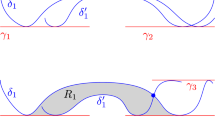Abstract
We study arrangements of intervals in \({\mathbb {R}}^2\) for which many pairs are concyclic. We show that any set of intervals with many concyclic pairs must have underlying algebraic and geometric structure. In the most general case, we prove that the endpoints of many intervals belong to a single bicircular quartic curve.











Similar content being viewed by others
Notes
A circle is ordinary if it contains exactly three points of P.
References
Casey, J.: On bicircular quartics. Trans. R. Irish Acad. 24(Science), 457–569 (1871)
Chazelle, B., Edelsbrunner, H.: An optimal algorithm for intersecting line segments in the plane. J. Assoc. Comput. Mach. 39(1), 1–54 (1992)
Di Benedetto, D., Solymosi, J., White, E.P.: Combinatorics of intervals in the plane I: trapezoids. Discrete Comput. Geom. 69(1), 232–249 (2023)
Fletcher, R.R., III.: Geometric ramifications of invariant expressions in the ternary hypercommutative variety. In: New Trends and Advanced Methods in Interdisciplinary Mathematical Sciences. STEAM-H: Science, Technology, Engineering, Agriculture, Mathematics & Health, pp. 107–122. Springer, Cham (2017)
Foraker, F.A.: Determinants in elementary analytic geometry. Am. Math. Mon. 27(2), 57–61 (1920)
Glaister, P.: Intersecting chords theorem: 30 years on. Math. Sch. 36(1), 22 (2007)
Green, B., Tao, T.: On sets defining few ordinary lines. Discrete Comput. Geom. 50(2), 409–468 (2013)
Guth, L., Katz, N.H.: Algebraic methods in discrete analogs of the Kakeya problem. Adv. Math. 225(5), 2828–2839 (2010)
Guth, L., Katz, N.H.: On the Erdős distinct distances problem in the plane. Ann. Math. 181(1), 155–190 (2015)
Hilton, H.: Plane Algebraic Curves. Clarendon Press, Oxford (1920)
Kaplan, H., Sharir, M., Shustin, E.: On lines and joints. Discrete Comput. Geom. 44(4), 838–843 (2010)
Kollár, J.: Szemerédi–Trotter-type theorems in dimension 3. Adv. Math. 271, 30–61 (2015)
Lin, A., Makhul, M., Mojarrad, H.N., Schicho, J., Swanepoel, K., de Zeeuw, F.: On sets defining few ordinary circles. Discrete Comput. Geom. 59(1), 59–87 (2018)
Pach, J., Sharir, M.: On vertical visibility in arrangements of segments and the queue size in the Bentley–Ottmann line sweeping algorithm. SIAM J. Comput. 20(3), 460–470 (1991)
Pach, J., Sharir, M.: Combinatorial Geometry and its Algorithmic Applications: The Alcalá Lectures. Mathematical Surveys and Monographs, vol. 152. American Mathematical Society, Providence (2009)
Salmon, G.: A Treatise on Conic Sections, 6th edn. Chelsea, New York (1954)
Salmon, G.: A Treatise on the Higher Plane Curves: Intended as a Sequel to “A Treatise on Conic Sections’’, 3rd edn. Chelsea, New York (1960)
Solymosi, J., de Zeeuw, F.: On a question of Erdős and Ulam. Discrete Comput. Geom. 43(2), 393–401 (2010)
Tóth, Cs.D.: Binary plane partitions for disjoint line segments. Discrete Comput. Geom. 45(4), 617–646 (2011)
Wiernik, A., Sharir, M.: Planar realizations of nonlinear Davenport–Schinzel sequences by segments. Discrete Comput. Geom. 3(1), 15–47 (1988)
Acknowledgements
The authors thank Daniel Di Benedetto for valuable suggestions and conversations throughout the preparation of this paper. The research of the first author was supported in part by an NSERC Discovery grant and OTKA K 119528 grant. The research of the second author was supported in part by Killam and NSERC doctoral scholarships.
Author information
Authors and Affiliations
Corresponding author
Additional information
Editor in Charge: Csaba D. Tóth
Dedicated to the memory of Eli Goodman.
Publisher's Note
Springer Nature remains neutral with regard to jurisdictional claims in published maps and institutional affiliations.
Appendix
Appendix
Below we give the bicircular quartic curve \(P(a,b)=0\) discussed in Sect. 4.3. The constant term is 0. The degree four homogeneous component:
Degree three homogeneous component:
Degree two homogeneous component:
Degree one homogeneous component:
Rights and permissions
Springer Nature or its licensor (e.g. a society or other partner) holds exclusive rights to this article under a publishing agreement with the author(s) or other rightsholder(s); author self-archiving of the accepted manuscript version of this article is solely governed by the terms of such publishing agreement and applicable law.
About this article
Cite this article
Solymosi, J., White, E.P. Concyclic Intervals in the Plane. Discrete Comput Geom (2023). https://doi.org/10.1007/s00454-023-00515-y
Received:
Revised:
Accepted:
Published:
DOI: https://doi.org/10.1007/s00454-023-00515-y




